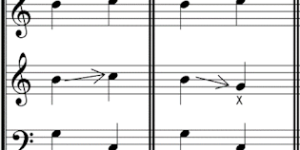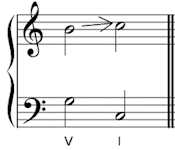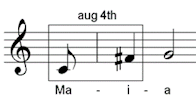Voice Leading and Consecutives (Keyboard Reconstruction)
This lesson refers to the keyboard reconstruction question (Q2. ABRSM Grade 8 Music Theory). Voice Leading and Consecutives Although you are writing for piano rather than in four part harmony, you should …
Voice Leading in Minor Keys
Dissonant Melodic Intervals Augmented and diminished melodic intervals are uncommon but do sometimes occur. Dissonances should resolve by step: move from the dissonance to the nearest possible note. In most …
3-Part Voice Leading
3-Part Texture Most of the harmony rules we have learned up to now have been based on 4-part, SATB harmony. Music can, of course, be written for any number of …
False (Cross) Relations
False (Cross) Relations A false (or cross) relation occurs when a note is placed in close time proximity to a chromatically altered version of itself, in another part. For example, …
Crossing Parts
The phrase “parts cross” means that between two parts, the higher one moves downward in pitch so far that it becomes the lower one (or the lower part moves above …
Keyboard Voice Leading
We have already learned that the normal voice leading behaviour of the leading note is to rise by step, if the chord progression is V-I, and that in a 4-part …
Consecutive 5ths and Octaves
When two parts form a harmonic interval of a perfect 5th, this should not normally be followed by another perfect 5th between the same two parts, in Classical harmony. This …
Leading Notes and 7ths
Voice Leading Leading Notes The behaviour of the leading note is crucial to writing good harmony, and good compositions. The 7th degree of the scale is called the “leading note” …
Augmented and Diminished Intervals
Aug/Dim Melodic Intervals If the interval between one note and the next in a tune is an augmented or diminished interval, the interval is dissonant and needs to be treated …









